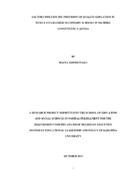Factors Influencing Provision of Quality Education in Newly Established Secondary Schools in Mathira Constituency, Kenya
Abstract
In the last ten years, there has been an establishment of new secondary schools across
Kenya, rising out of increased demand for secondary education, government policy to
enhance access of education and provision of resources through Constituency
Development Funds. However, quality issues in these schools are a point of concern
for educational researchers. In view of this, the purpose of this study was to assess the
factors influencing quality education provision in the newly established secondary
schools in Mathira Constituency, Kenya. The objectives of the study were: To assess
the status of learning resources in the newly established secondary schools, analyse
the entry behaviour of students in the newly established secondary schools, assess
teachers’ competency level in the newly established secondary schools and to evaluate
the challenges facing newly established secondary schools in Mathira Constituency.
The study employed Context, Input, Process Product (CIPP) theory as postulated by
Stufflebeam and Coryn. The study adopted a descriptive survey design. The target
population comprised of 85 teachers and 10 principals. Simple random sampling
method was used to select 70 teachers and then 10 principals were selected
purposively for the study. The research instruments used open-ended questionnaires,
interview schedules and observation guides. The instruments were tested for
reliability and posted a correlation coefficient of 0.72 and 0.71 for principals and
teachers questionnaires respectively. Data was coded, analysed and presented using
descriptive statistics such as percentages. Qualitative data was thematically arranged
and patterns established which are presented in form of statements. The finding of the
study revealed that newly established schools lacked the necessary infrastructure for
provision of quality education. The study also established that the majority of the
newly established schools lacked adequate resources, were highly understaffed and
admitted learners with low entry behaviour thereby compromising the provision of
quality education. The study therefore concludes that the newly established schools
have gaps that need to be filled if the quality agenda is to remain paramount. The
study further recommends that there should be concerted efforts to elevate the profile
of those schools through increased funding, provision of teachers and enhance
teachers’ capacity which will ultimately raise the quality education provision in these
schools.
